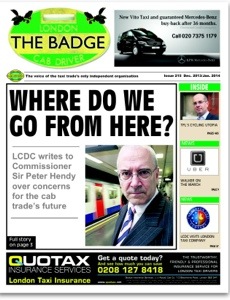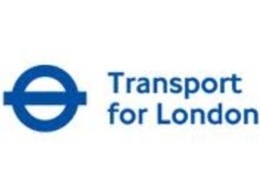Monthly Archives: December 2013
Police Appeal
Appeal 1
Police are keen to trace the driver of a taxi that picked up a man and a woman in Surbiton on Friday night in connection with an allegation of rape. They were picked up at about 12.30am on 07/12/2013 on Victoria Road, Surbiton opposite the YMCA.
The woman was white, 40 years old wearing a white furry jacket. The man was also white, 33 years old and balding.
They were dropped off at Cheyne Hill, Surbiton and it is believed that the woman gave the man cash to pay the fare.
Police would like to speak to the driver concerning the demeanour of the passengers. Please contact the officer in the case, DC Peter Condron Met. Police Sapphire Command. Anyone with information should telephone 020 8649 0424 quoting reference 0411319/13
Appeal 2
Police are keen to trace the driver of a taxi in the Greenwich/Lewisham area of London who witnessed an assault in the rear of his cab on 30 November 2013 at around 00:30 hours.
The white middle-aged male victim hailed the cab in Blackheath Hill and got in, but was immediately followed by a black male who assaulted the passenger in the rear of the taxi and stole his possessions. The driver took the victim home to Amersham Road in SE14.
Police would like to speak with the driver and ascertain more details surrounding the incident. Anyone with information should contact TDC Bryant of The Serious and Accusative Crime unit in Greenwich on 0208 284 9500 quoting reference 3227177/13.
Transport for London Taxi Driver Survey
Transport for London Taxi Driver Survey
As part of the ongoing work to reduce harmful emissions in London and improve air quality we have commissioned research to investigate the potential for using electric or plug-in hybrid vehicles as taxis (black cabs) in London. At present no electric or plug-in vehicles are available for use as London taxis, but it is possible that suitable vehicles may be available in the future.
It is important that we understand what infrastructure might be needed for such vehicles to be operationally and commercially viable. To do this, we are asking taxi drivers to complete a short survey about their working patterns, working hours, areas worked and where breaks are taken.
A pilot of the survey has recently been conducted to test this. The full survey is now available here and all licensed taxi drivers are encouraged to complete it.
As licensed London taxi drivers, your views on this matter are essential to this research and so we would be grateful if you could complete the survey. Completing the survey only takes around 15 minutes and all results are anonymous and confidential. The results from the survey will be used to help understand drivers’ views on electric vehicles and potential locations for rapid charging points for electric taxis. Once you start the survey you can save it part way through and then return to it later.
Everyone who completes the survey will also be invited to enter a prize draw to win one of two £50 Amazon vouchers.
The closing date for the survey is Monday 13 January 2014.
UK government paves way for driverless cars
The government has announced that it wants to make the UK a world centre for the development of driverless cars.
It said it would conduct a review next year to ensure that the legislative and regulatory framework is in place for such vehicles to be incorporated on Britain’s roads.
It will also create a £10m prize to fund a town or city to become a testing ground for autonomous vehicles.
Milton Keynes is already experimenting with driverless pods.
By mid-2017 it is planned that 100 fully autonomous vehicles will run on the town’s pathways along with pedestrians, using sensors to avoid collisions.
The plans for self-drive cars were announced in the chancellor’s National Infrastructure Plan.
Radical change
Much of the hype around driverless cars centres around Google. Its self-drive car recently completed 500,000 miles (804,000km) of road tests.
In the US, California, Nevada and Florida have passed legislation to allow driverless cars.
This month Nissan carried out the first public road test of an autonomous vehicle on a Japanese highway.
Many envisage a future when we may not own cars at all but simply hail one to fulfil all our transportation needs.
“I call it mobility on demand. You pop out your mobile phone, say where you want to go and how many people and in a short amount of time a vehicle rolls up,” said Brad Templeton, software engineer and adviser to Google on its self-drive car project.
“People will be like the millionaires of old where you just had a driver that did everything. These cars will worry about recharging, parking and refuelling. They will drive down a road without you paying much attention to it,” he said.
Such cars will make cities both safer and greener, he thinks.
“It will radically change the amount of energy we use, how congested our streets are and eliminate most of the parking lots that take up a huge amount of space in our cities.
“Humans kill 1.2 million people in car accidents each year so the idea of being able to make a safer vehicle is very appealing,” he said.
Many think that the issue of who will be liable in the event of accidents will hold up the development of autonomous vehicles but Mr Templeton is not convinced.
“I think only the barristers will find it the most interesting question,” he said.
“For me the more interesting question is whether a machine is more liable than a drunk driver. Countries that decide a machine is more liable will slow the development of this technology,” he added.
Car manufacturers suggest that autonomous vehicles will be on the roads within the decade.
Google has given 2017 as the date its cars will hit the roads. Not to be outdone, Elon Musk, head of electric car company Tesla Motors, has said he will have such vehicles ready in 2016.
Other car manufacturers, including Daimler and Nissan have given a 2020 date for their own versions.
Much of the underlying technology for autonomous driving is already installed in cars such as the Mercedes S500 which uses onboard radar and 3D stereoscopic cameras to gauge the distance from other cars.
SOURCE: BBC NEWS



